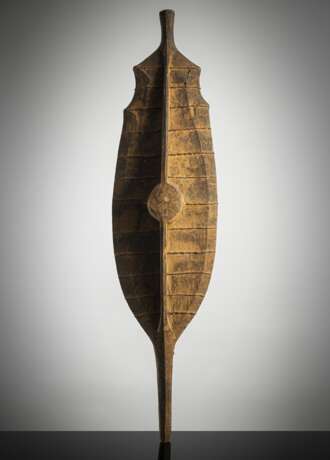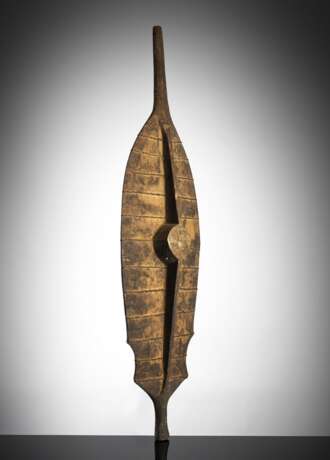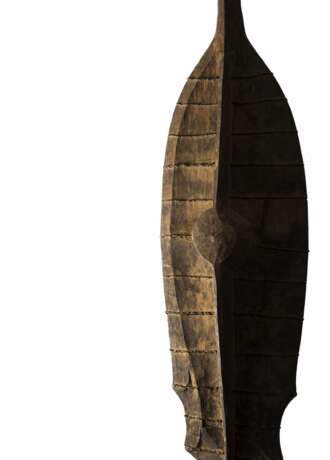ID 1218039
Lot 1522 | Seltenes Schild ''baluse'' der Ono Niha
Estimate value
€ 1 200 – 1 800
H. 133,5 cm
Ein seltener, gut erhaltener Kampfschild von der Insel Nias südlich von Sumatra. Der ovale, blattförmige und leicht gewölbte Schild ist aus einem Stück Holz geschnitzt und mit horizontal angebrachten Rattanbändern verstärkt. Von der oberen bis zur unteren Spitze verläuft ein erhabener Grat, der in der Mitte in einen Schildbuckel einmündet. Rückseitig ist in diesen der Haltegriff eingeschnitzt. Gute Schilde wie der vorliegende sind immer aus einem Stück gefertigt, mindere Exemplare haben angesetzte Teile (Griffe). Die Form des baluse wird symbolisch mit einem Krokodil assoziiert. In Südostasien geht die mythologische Bedeutung des Krokodils einher mit dem Glauben an verstorbene Herrscher oder Ahnen, die als Krokodile wieder auf die Welt gekommen sind. Schilde wie dieser wurden (und werden) im fatalya-Tanz in Kombination mit Schwertern und Speeren getragen. Die realen Fehden, die bei den berühmten Steinsprüngen und Tänzen so eindrücklich geübt und in Szene gesetzt wurden (und werden), waren von kurzer Dauer und hatten eher Überfall-Charakter, wobei die Erbeutung von Köpfen für Baueinweihungen und bedeutsame Festivitäten (d.h. gemeinschaftliche Großprojekte) eine wesentliche Motivation war. Speere waren im Kampf die eigentliche Offensivwaffe. Zudem werden schon seit Jahrhunderten zur Verteidigung der Dörfer, wie bei anderen Nord-Sumatranern (z.B. Alas, Batak, Aceh), auch Gewehre benutzt. Die Kultur der Ono Niha ist vor allem durch Dörfer mit spektakulären Monumentalbauten (Clanhäuser) aus mächtigem Balkenwerk und gepflasterten Straßen berühmt, die zum Weltkulturerbe zählen. Berühmt ist auch der „Steinsprung“ der Krieger, bei dem über 2 m hohe Steinmauern mit spektakulären Sprüngen überwunden werden.
Aus einer alten deutschen Privatsammlung, seit den 1950er Jahren gesammelt - Minim. Altersspuren, teils kleine Best.
Lit.: Barbier, J. / Newton, D. (1988): Islands and Ancestors. Indigenous Styles of Southeast Asia. New York. - Bonatz, D. (2001): Wandel einer Megalithkultur im 20. Jahrhundert (Nias/Indonesien). In: Anthropos, Band 96, Heft 1 - Hämmerle, J. (2006): Society and Culture in Nias; Vienna Conference. Wien. - Volkenkundig Museum Nusantara (1990). Nias: Tribal Treasures: Cosmic Reflections in Stone, Wood, and Gold. Delft. - Mittersakschmöller, R. (1998): Joachim Freiherr v. Brenner-Felsach. Eine Reise nach Nias. Unveröffentlichte Manuskripte aus dem Museum für Völkerkunde in Wien. Materialien zu Exotismus und Ethnographie
| Auction house category: | Ethnographic tribal art |
|---|
| Auction house category: | Ethnographic tribal art |
|---|
| Address of auction |
Nagel Auktionen GmbH Neckarstrasse 189 - 191 70190 Stuttgart Germany | ||||||||||||||
|---|---|---|---|---|---|---|---|---|---|---|---|---|---|---|---|
| Preview | |||||||||||||||
| Phone | +49 (0)711 649 690 | ||||||||||||||
| Fax | +49 (0)711 649 69696 | ||||||||||||||
| Buyer Premium | 29,5% | ||||||||||||||
| Conditions of purchase | Conditions of purchase | ||||||||||||||
| Business hours | Business hours
|





